While basil is often considered one of the easiest herbs to grow for new gardeners, that doesn’t mean it comes without its own problems when growing it.
This guide will help you diagnose your basil plant problems and determine what the issue might be, and how to fix it.
What’s Wrong With My Basil Plant?
There are 3 categories of problems that could be causing your basil plant to not be as healthy as it could be:
- Diseases
- Pests
- Nutrient Deficiencies
I’ll break down all 3, with the common issues for each one, and how you can fix and prevent those in the future.
Diseases That Affect Basil Plants
There are a few basil diseases you’ll want to keep an eye out for as a gardener when growing almost any type of basil. Most of these problems can be avoided by not overwatering your basil, making sure to plant basil in the right soil with proper drainage, and providing good air circulation.
1. Downy Mildew Disease
Downy Mildew is one of the common diseases that can impact basil plants.
The most common symptoms of downy mildew disease are basil leaves turning yellow or brown.
If the leaves are yellow in color, check the underside of the basil leaves and see if you find something that looks like dirt or a cobweb. This is a tell sale sign of downy mildew.
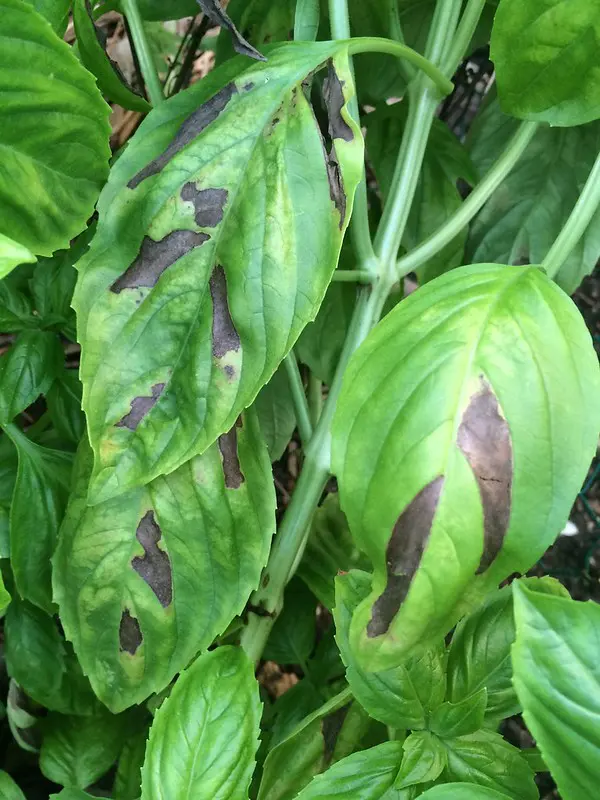
How to Fix It
This is one of the times you might just want to get rid of the plant altogether. Even if it looks like only one leaf is affected, it’s likely that downy mildew has already started to spread around the plant.
Save your time and energy and start another basil plant if you can.
How to Avoid It
Make sure you water your basil plants in the morning as opposed to the afternoon or evening. Basil needs time to dry out and absorb the water.
When you water your basil plants at night, it kind of just sits there and starts to attract pests and diseases, like downy mildew.
2. Root Rot
Root rot happens in a basil plant that has been overwatered continuously has soggy soil and does not have proper drainage. This could be the cause of a basil plant wilting and/or basil having yellow leaves, and the stems of the plant will turn brown.
Root rot is most commonly a “user error” with basil as it’s often caused by prolonged overwatering of the plant. This is more common when planting basil indoors, as when planted outside, basil has the whole ground to drain water too if needed. Inside, they are confined to a smaller area with less places for the water to drain to.
How to Fix The Problem
Try giving the basil plant a few days without watering it. It’s going to seem weird, but if you’re overwatering the plant, it’s going to need a little break.
After 24-48 hours, water the basil plant again but using a spray bottle this time to help make sure you don’t overwater the plant. Try using the spray bottle to water the plant for the next 5-7 days until you get a feel for how much water the plant truly need each day.
You can also try a more automated “drip irrigation” system, but this can be costly and/or timely to set up.
How to Avoid Root Rot
Root rot can be avoided by not overwatering your basil plants. When you overwater your plants, you are causing the roots to sit in water, and effectively drowning them. This creates a perfect home for basil diseases to swoop in and take over the plant.
Give the roots of your basil enough good air circulation by watering your plants less frequently, and only when the soil seems dry to the touch.
3. Bacterial Leaf Spot Disease
This disease is caused by a bacteria called Pseudomonas Cichorii.
Leaf Spot disease kind of looks like ringworm on a basil plant. It looks like a brown spot with white or gray in the middle of the ring.
The stems of basil plants will often have brown streaks on them as well.
Bacterial Leaf Spot is spread through infected soil being put on your plant.
How to Fix It
Remove any infected plants as soon as you find them to help keep the disease from spreading.
If you remember which soil you used when you started your basil seeds, go ahead and get rid of that bag as it is likely all affected. If you’ve used that soil on other plants, you’re going to want to keep a close eye on them as well.
How to Avoid It
This is one you can’t really avoid, unless you get all of the soil you purchase tested before using it, but that seems a little “extra” and you’ll probably want to spend your time actually growing plants.
4. Fusarium Wilt
Fusarium wilt is one of the more common basil diseases, and while it can impact most basil varieties, it most frequently causes problems with Italian or sweet basil. Your basil leaves might be changing colors (yellow or brown), as well as drying out. You often see streaks or spots along the stems of the basil plant as well.
Fusarium wilt is one of the problems that is almost impossible to get rid of.
How to Fix It
Sadly, this one can’t really be fixed, and you’ll want to get rid of the basil plant. Make sure to NOT put it in your compost pile as this can spread the fusarium wilt to your beautiful black gold.
How to Avoid It
The only real way to prevent fusarium wilt is to rotate the herbs and vegetables you’re growing each year and through sterilization of the soil. Rotating crops helps make sure each area of soil isn’t drained of the same level of nutrients each growing season.
Most seed starting mixes are sterilized, but you’ll want to make sure of this as it can greatly benefit plants. If yours isn’t, sterilization is pretty easy to do yourself to help avoid problems like fusarium wilt on your basil.
5. Damping Off
Damping off is a soil-borne fungal disease that causes your basil plant to appear like it is rotting from the bottom up.
How to Fix It
There isn’t an easy to way to fix damping off. You’ll want to get rid of the soil you’re using and discard the plant (not in your compost bin as it could spread the disease to the entire compost lot).
How to Avoid It
To avoid experiencing damping off, use sterilized trays for seed starting, and make sure your soil is sterile as well. While sterile often sounds like a bad thing in other applications, when it comes to gardening you want things to be sterile so you’re not spreading around disease and fungus to your other plants.
Pests That Affect Basil Plants
Diseases aren’t the only problems impacting basil plants, there are quite a few insects who love dining on basil leaves.
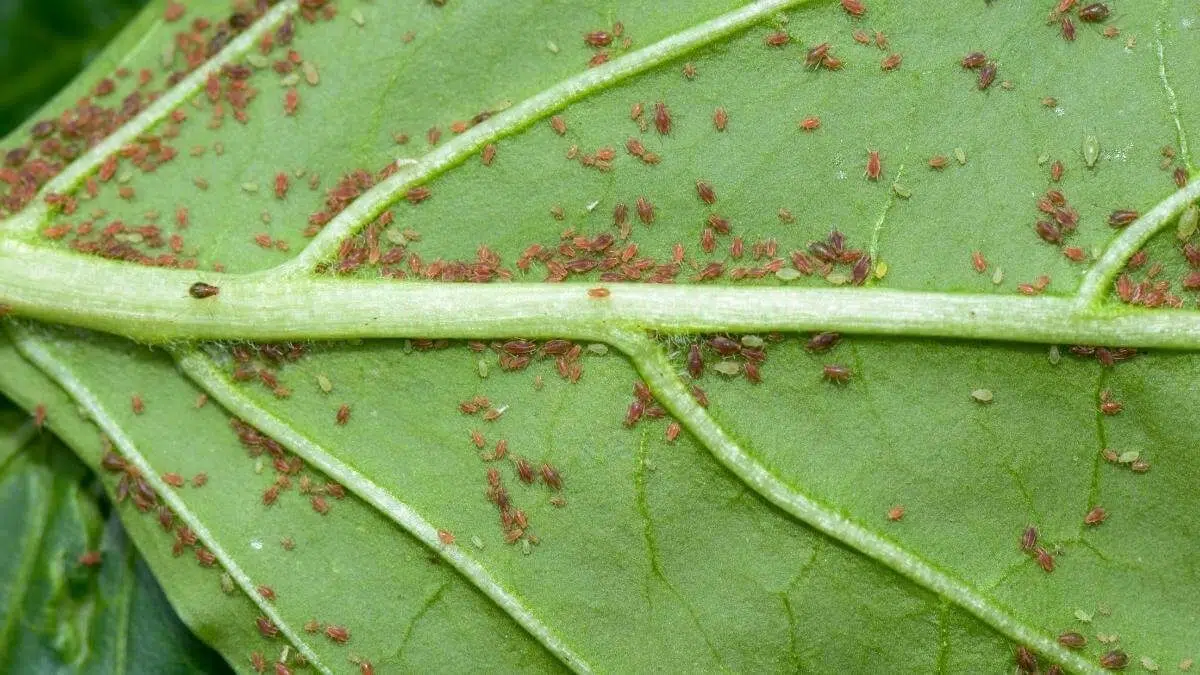
6. Aphids
Ahh, the glitter of gardening. Aphids suck, and they are pretty hard to avoid. Aphids are often found on basil plants and make growing basil a little more challenging.
Aphids can make their appearance as a problem pretty early on in the seedlings life and impact most basil varieties. If you find aphids, just know that this is a common occurrence and there are quite a few ways you can help mitigate the problem.
How to Get Rid of Aphids
There are a few good options for getting rid of aphids.
Hydrogen Peroxide Spray
You can use a hydrogen peroxide solution and wipe them off of your basil plants.
Diatomaceous Earth
But my favorite method is to spread diatomaceous earth on your plants. It won’t hurt the herb plant or leaves, but it will make it a terrible home for pests as the fine dust gets into their shells and they won’t want to come back.
How to Avoid Aphids
There are basil companion plants you can plant nearby that deter aphids and other pests.
Cilantro, dill, garlic and onions are all plants that repel aphids and are great to plant near your basil.
7. Root-Knot Nematodes
Root-knot nematodes get their name because they cause what looks like knots in the roots of your plant – they cause the roots to swell after they eat.
If your plant is wilting, not growing well or are turning yellow – this could be what you’re experiencing. While basil is not commonly impacted by nematodes, it’s good to keep in mind as it is possible.
They are generally found in warmer climates with short winters, but if you’re growing plants inside – that’s you! 🙂 Most seed companies do offer seed varieties that are Nematode resistant – you’ll see a capital “N” on the seed packet.
How to Fix It
Sadly, I don’t think your basil plants will survive this one. You’ll want to remove and get destroy the affected plants, making sure to remove the roots from the area.
Soil solarization is one of the only ways I’ve seen to actually get rid of this issue, but your plants won’t exactly survive this. Here are the instructions for soil solarization.
How to Avoid It
Using nematode-resistant varieties of seeds can help avoid root-knot nematodes. They do prefer sandy soil so try an
8. Flea Beetles
Ugh, these guys are really frustrating. They don’t just affect basil leaves, but also tomatoes, radishes, broccoli, cabbage, turnips, peppers, potatoes, spinach, and more.
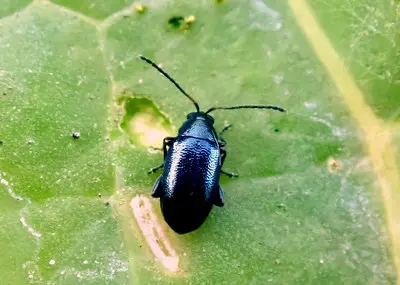
If you’ve ever seen holes in your basil leaves, it could very well likely be from a flea beetle, as they chew misshapen holes in plant leaves.
Flea beetles are most active in the early spring and slowly start to decrease in numbers.
How to Fix It
The only organic and decent way to get rid of them that I’ve come across is good ole diatomaceous earth. I feel like I mention this anytime I bring up pests, but it’s really a great way to help keep your plants growing best without bugs.
How to Avoid It
Floating row covers over your plants can help thwart off flea beetles and other pests. Just remember to remove the row covers once plants are flowering so pollinators can reach them and do their job.
9. Fungus Gnats
Fungus gnats are those little gnats you find on your basil plant, usually when you’re starting seeds indoors and end up overwatering your plant.
While they generally don’t harm the leaves themselves, they can indirectly stunt plant growth, as well as cause some yellowing of your basil leaves.
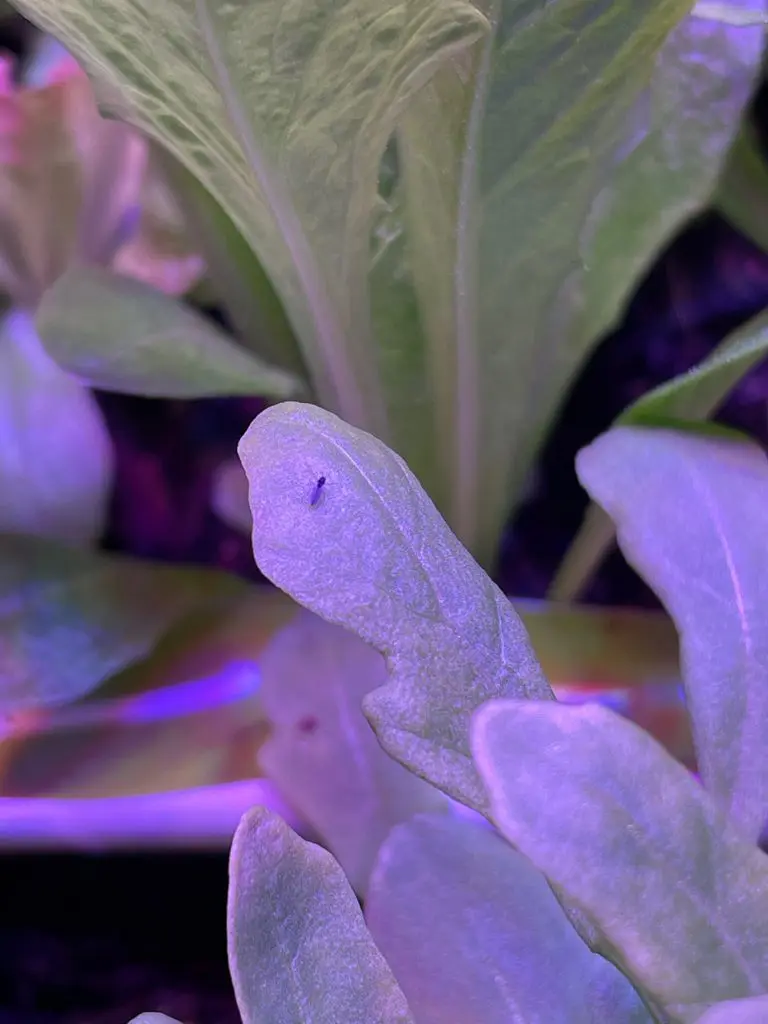
How to Get Rid of Fungus Gnats
You can try a few things to help you get rid of fungus gnats flying around your basil.
Diatomaceous earth works well for this too. You can spread it across the surface of the soil and it should stop the gnats from breeding. While it wont kill the adult gnats, eventually they will die off and not be replaced, saving your basil plant from this problem.
Yellow sticky traps are great for catching those other guys. I just ordered these ones and they are working great so far.
How to Avoid Fungus Gnats
Fungus gnats come around when you overwater your basil plant, or any other indoor plant for that matter. They need that moist soil to thrive so when you overwater your plant and it doesn’t use up all the moisture, fungus gnats will come flocking!
Overhead watering makes it easy for you to overwater, so I’d recommend trying to learn a technique like bottom watering to help avoid this in the future.
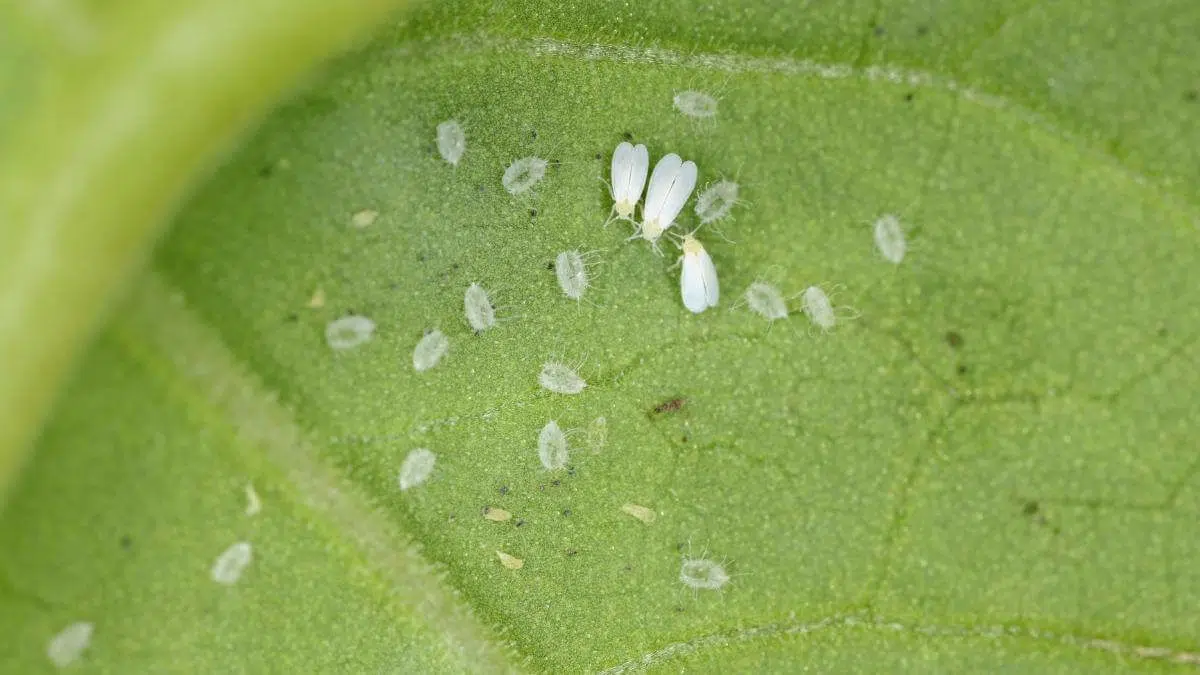
10. Whiteflies
Whiteflies are closely related to aphids and mealybugs but are not exactly the same thing. Whiteflies appear on the bottom of leaves and are most active during the day.
How to Fix It
Get your hose ready, because you’re going to blast these suckers. As with aphids, you want to start by spraying the infested basil leaves with water to cause the whiteflies to scatter and remove some of the eggs and nymphs.
Then spray the plant with a mix of dish soap and water – you only need about a drop of soap per gallon of water. I’d probably stick to an organic dish soap, since you are going to be spraying this on a basil plant you intend to eat.
You can also use an organic insecticide to help remedy whiteflies.
11. Snails & Slugs
Slugs seem to appear out of nowhere and quickly lay enough eggs to build a decent sized colony in your herb garden. While they might travel slow, the problems they cause don’t take much time to appear, and soon you might notice some holes in your basil.
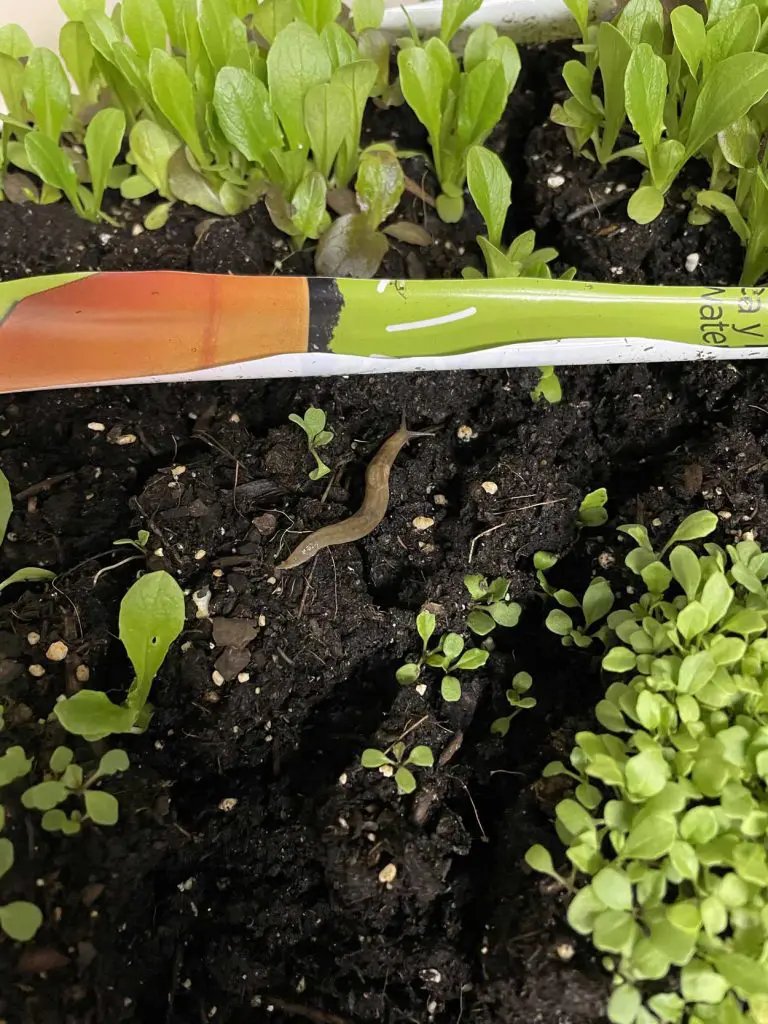
I kind of freaked out when I saw this guy (above) roaming around my indoor herb garden as it was my first encounter with slugs and growing plants.
How to Fix It
Remove any slugs or snails from the soil and/or basil plant that you can find. Then check for eggs and larvae – they look like little balls of water or clear marbles spread throughout the soil. Remove as many of those as you can.
They eggs/larvae are pretty sticky so you can use a pencil or some kind of tool to get them out of the garden soil. I just put them in a bag and tossed them as to avoid having them appear again.
How to Prevent Slugs and Snails
Apparently copper is one of the materials that slugs despise. I don’t understand why this works, but there are tons of videos and images of people playing copper or copper tape around their garden and the slugs essentially turn around when they get to it. Pretty cool!
Nutrient Deficiencies
Plants need specific nutrients to grow full size and continue producing fruit and or in the case of basil, delicious leaves.
12. Nitrogen Deficiency
Nitrogen deficiency can cause yellowing leaves on your basil plant, usually towards the base of your basil plant. Your basil may also stay smaller than normal as basil grows best when it has all the nutrients it needs.
13. Phosphorus Deficiency
Phosphorus deficiency appears on basil plants as purple spots or areas on your lower leaves of the basil plant. A deficiency in phosphorus seems to be correlated to basil flowers appearing earlier than normal as well.
14. Potassium Deficiency
This appears are brown spots on leaves, eventually turning into leaves that are yellow and brown on the ends. This seems to be more common in hydroponics and container gardens.
How to Fix Nutrient Deficiencies
You can add certain nutrients to your plants throughout their life cycle using fertilizers and fertilizer concentrates. Dr. Earth is a highly recommended fertilizer that is also organic, which I appreciate.
While there are a lot of problems you might encounter when growing basil, it’s usually wroth it when you’re able to make fresh pesto or add some leaves to a dish you cook up.


